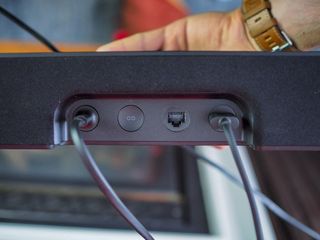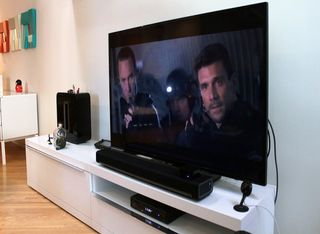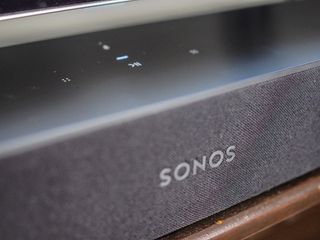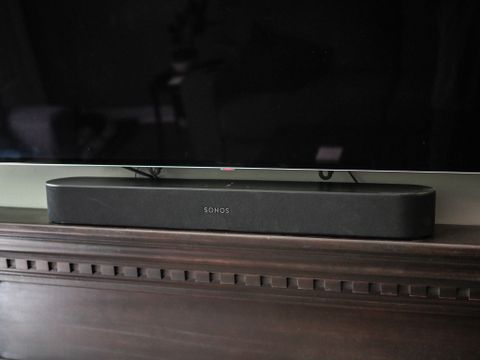In the world of soundbars, to say there's variety in what's offered, and how much you can pay, is an understatement. Searching "soundbar" on Amazon sees companies like Vizio offering a basic $75 option that's no-frills and pretty well-received, while big names like Yamaha offer hardware twice the size with an included subwoofer — and a $300 price point.
But neither options do, or even claim to do, what Sonos soundbars offer. Sonos is in a league of its own, both for sound quality and extensibility. Adding a Sonos soundbar to your TV experience doesn't just amp the sound; it opens up convenient music streaming options through Sonos's excellent app, and when connected to the company's other speakers, facilitates seamless whole-home audio playback from nearly any source.
Sonos offers two soundbars, the compact and modern $399 Beam and the older, larger, ultra-powerful $699 Playbar. Most people should buy the Beam, and I'll explain why shortly, but there's still a market for the Playbar.
Beam vs. Playbar The similarities and differences


At their cores, both the Playbar and Beam are meant to connect directly to a TV set to replace its usually-terrible onboard speakers. Once installed, they take over the main output from the TV and, once configured, respond to the volume controls on your TV's remote control.
Note: If you're already using a receiver, both soundbars assume that all your inputs — Apple TV, Switch, etc. — will be connected directly into your TV's HDMI ports, since neither speaker is designed to be used as passthrough when connected to a receiver. Most TVs have between two and four HDMI ports, and most modern receivers have more than that — if you require more HDMI inputs than your TV currently allows, neither the Beam nor the Playbar will be appropriate for your setup.
| Sonos Playbar | Sonos Beam | |
|---|---|---|
| No. of Woofers | 6 | 4 |
| No. of Tweeters | 3 | 1 |
| No. of Radiators | N/A | 3 |
| No. of Amplifiers | 9 (Class D) | 5 (Class D) |
| Optical Audio | Yes | Yes |
| HDMI-ARC | No | Yes |
| Alexa support | No | Yes |
The Playbar, which was released in 2013, is a very large piece of equipment, meant for large living rooms to small theaters. It's built to rest just in front of a flat-screen TV, on a console or ledge (Sonos logo facing up) or mounted on a wall below the TV (Sonos logo facing forward). Because of its large enclosure, Sonos placed six woofers for bass, three tweeters for mids and highs, and nine Class D amplifiers for power, to fill a room with sound.
At 35 inches in width and just under 12 pounds in weight, the Playbar, which is only available in black, is an imposing piece of equipment that looks more comfortable below a television 55 inches in size or higher.
| Sonos Playbar | Sonos Beam | |
|---|---|---|
| Width | 35.3" | 25.63" |
| Height | 3.35" | 2.7" |
| Depth | 5.51" | 3.94" |
| Weight | 11.9 lbs | 6.2 lbs |
On the flip side, the Beam is available in either black or white, and is not just narrower but stouter and skinnier than the Playbar — it was able to fit on the ledge below my LG B7 OLED TV where the Playbar could not. It also benefits from Sonos's more modern design ethos that it debuted with the Play:1 and new Play:5 — it's rounder and more inviting but manages to disappear into the environment thanks to its color uniformity.
The Beam's smaller stature translates into a sound more appropriate for a small-to-medium-sized living area. It has just four woofers, a single tweeter, and three passive radiators in which sound bounces around before being shot out of the speaker. Five Class D amplifiers ensure the top volume is loud enough for most people, but the Beam is not designed for capacious living areas or home theaters.
Sound

The difference between the Playbar and Beam in terms of sound output is significant. The Playbar just has more space to work with, and more individual components from which to send sound directionally. Directionality and soundstage are only important for the mid-range and high-end of a movie or song (bass, or low end, spreads outward from its source but does not care about direction), but it makes a big difference in making a soundbar feel like two, or even five, separate speakers.
In this case, the Playbar is the clear winner: an explosion on the right of the screen sounds like it's coming from that side, thanks to dedicated drivers, and dialog emerges from a dedicated tweeter in the middle clearer and more distinct than that of the Beam. Bass rumbles more deeply and more accurately than that of the Beam, too, and couches far from the Playbar can feel the effects more easily.

Playbar's numerous drivers have the same dramatic effect on music as they do on movies and TV shows: not only can the speaker go louder, filling more of space with beautiful harmonies, accurate bass, and pleasing, warm mids, but the separation of instruments and vocals feel more natural.
The Beam sounds very good, too, and produces sound larger and more versatile than one would assume from its size — watching Star Wars: The Last Jedi was about as visceral a movie-watching experience as I can remember — but the components of dialog, sound effects, and music all emerges from the same place. Whereas the Playbar truly makes you believe you're listening to a set of surround sound speakers, the Beam reminds you that you're listening to a very good speaker. Singular.
If you listen to a lot of music in your living room, the Playbar is going to sound a lot better than the Beam. For movies, the difference isn't as significant.
Keep in mind that for movies, the difference between the Playbar and Beam on their own isn't going to be significant except for those with large, cavernous rooms. The major difference in quality emerges when listening to music, where the Playbar pulls ahead by a wide (pun intended) margin.
Both the Playbar and Beam support true 5.1 surround sound playback by wirelessly syncing surround pairs and a subwoofer. You can make wireless pairs using two Play:1, Sonos One, or Play:5 speakers as rear surrounds, along with Sonos's $699 dedicated subwoofer. Doing so isn't cheap, and it's less necessary with the Playbar up front, but the irony is that many homes that have already invested the money in a Playbar may want to augment it with Sonos's other components.
Connectivity

Both the Playbar and Beam connect directly to a TV, but the former has only one input method: optical. That fiber-optic cable facilitates great sound, but it's limited in what else it can do.
On the other hand, the Beam is the first Sonos speaker to support HDMI-ARC, which connects directly to a compatible TV to perform a whole bunch of useful things, like working with the built-in Alexa speaker to turn the set on and off and, when used in conjunction with an Amazon Fire TV box or dongle, perform specific tasks. Those actions can include phrases like "Watch Handmaids Tale on Hulu" or "Play Rihanna on Spotify," which is super useful.
Note: HDMI-ARM is a standard that's been around for 10 years, and most TVs support it. But if you're using an older set or one that doesn't have an HDMI-ARC input (it's usually input #2 on most modern sets), Sonos includes an HDMI-to-optical adapter in the Beam's box.
HDMI-ARC also allows for the Beam's most useful feature: seamless switching between sound on the TV and sound from other places, be it a knowledge request from Alexa or playing a song on the Beam through the Sonos app. Here's the way it works: say you're watching a Netflix show on your Apple TV and decide to ask a question about the actor on screen. You can just say, "Alexa, who is X," and the database should spit out an answer. Once Alexa is finished, the sound should resume on the show automatically. If you paused it using the Siri remote, you can just press play again and sound will resume over the Beam. If you want to play a song on Beam through Spotify, you can ask Alexa to play whatever you want and the speaker will do its thing, resuming the TV audio once the song is finished.
The whole system is seamless and very useful, and it leads us to our next point of comparison...
Alexa and AirPlay 2

With Alexa built-in, the Beam boasts five directional microphones and a ton of smarts to be able to listen for the hot word at all times. While the Playbar technically supports Alexa, too, you'll need to link it with an Echo or Echo Dot speaker, which does the listening and routing on the Playbar's behalf. That extra step is a bit clunky and doesn't work nearly as well as it does on the Beam.
The Beam will also support AirPlay 2 through an update later this summer, and from early indications, it will be as seamless as it is on Apple's own HomePod speakers. That means using a nearby HomePod to build a whole-home audio setup, or just using Siri to route Apple Music throughout the house using various commands. Playbar will never support AirPlay 2, and for many Apple Music listeners that may be all they need to know.
Finally, Sonos does promise Google Assistant support for the Beam, but it's not clear when it will be added.
Who should buy the Playbar?

The Sonos Playbar is, surprisingly, still a very attractive product five years after its announcement. At its $699 price and its limited connectivity options, its appeal is quite limited, but it's also the best-sounding soundbar I've ever heard — by a mile. Crisp highs, beautiful, accurate mids, and deep, accurate, rumbling bass emerge from the six woofers and three tweeters, and if I had a bigger living room I'd probably still use it over the Beam.
Why? Because I have other smart speakers in my living room, including an Amazon Echo for Alexa and a HomePod for dedicated music. If I just wanted the best, most immersive sound possible from a soundbar, the Playbar would be my top pick.
But.
Who should buy the Beam?

At $399, the Sonos Beam is probably the most versatile soundbar on the market today. Not only does it play music, podcasts, and audiobooks from over 80 sources, including Apple Music, Spotify, Audible, and more, but it has built-in Alexa support for powerful smart home control, and among the best sound quality you'll find in a compact speaker.
The addition of HDMI-ARC is a big deal for Sonos because it opens the platform up to the future of TV control — voice. It also expands the viability of Beam in general, since its more attractive price and design will see people choosing it over cheaper, less capable soundbars. Sonos has also ensured that the Beam can be wall-mounted, though it requires a separate $59 accessory.
The Sonos Beam is the best soundbar available for most people today, and is a better product than the Playbar in almost every way. If size and convenience are more important than sound quality, the Beam is a no-brainer.
Which will you buy?
Are you interested in either the Sonos Beam or the Playbar?
Daniel Bader was a former Android Central Editor-in-Chief and Executive Editor for iMore and Windows Central.


